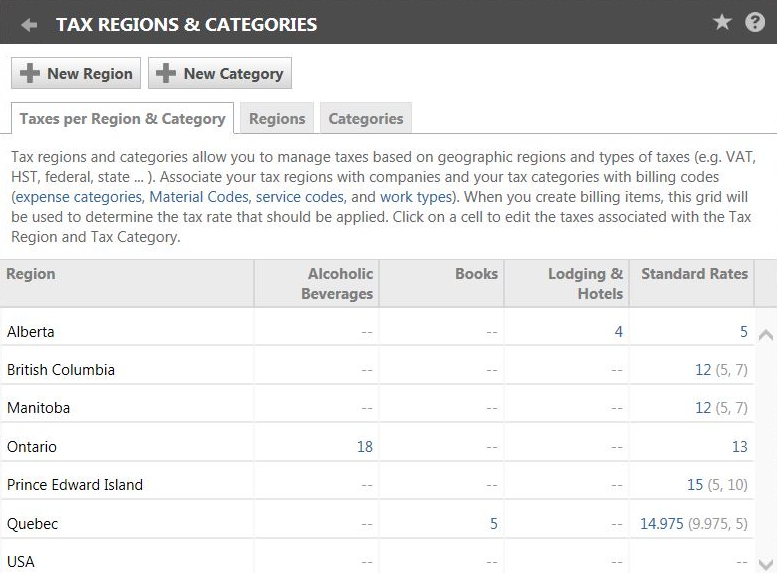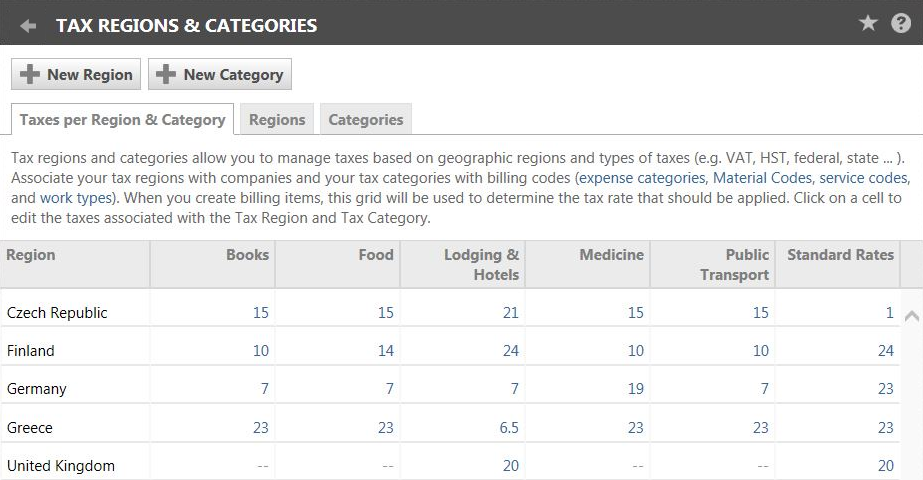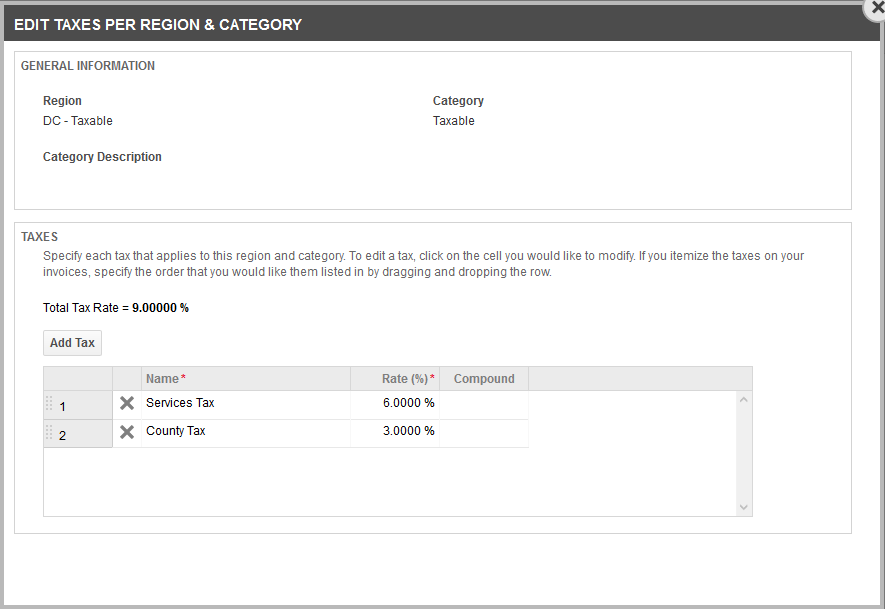Configuring your tax table
PERMISSIONS Security level with Admin permission to configure Finance, Accounting, & Invoicing. Refer to Admin security settings.
NAVIGATION Left Navigation Menu > Admin > Admin Categories > Features & Settings > Finance, Accounting & Invoicing > Tax Regions & Categories
Where should you calculate sales tax?
You have a number of options when it comes to calculating sales tax on your products and services. Refer to Calculating sales taxes.
Setting up a tax table in Autotask
If you generate either quotes or invoices in Autotask and would like to calculate taxes, you must fully configure your tax regions and tax categories, and populate your tax table as described below.
The tax on a billing item is determined by two factors:
- The customer location of your business and the location of your customer. Where your customer is located determines the tax jurisdiction and the taxation rules that apply.
- The product or service you are selling to a customer. Many tax jurisdictions have a standard VAT or sales tax rate, one or several lower rates, and possibly items that are tax-exempt.
Since it would be impossible for Autotask to keep up with constantly changing taxation rules and rates in thousands of tax jurisdictions, we allow you to build your own tax matrix that contains two completely configurable dimensions:
- Tax Regions - You configure a separate tax region for each tax jurisdiction you sell into. Each tax region will be represented by a row in the table. Refer to Tax regions.
- Tax Categories - You set up all tax categories that occur in any of the tax jurisdictions you have customers in. Each tax category will be represented as a column in the table. Refer to Tax categories.
Once the Tax Regions and Categories table is configured, you enter the applicable tax rates for each intersection of region and category. Refer to Populating your custom tax table.
Refer to the images below for a sample setup for the United States, Canada, and Europe. Note that the tax rates shown are for illustration purposes only. For current sales or VAT tax rates, consult your tax professional.
A tax region identifies the tax jurisdiction where the same tax rates apply to the same billing items.
- Tax regions can encompass entire countries, as is common in Europe. In Germany, the same tax rates apply in the entire country, so Autotask customers located in Germany with customers only in Germany need to set up one tax region.
- In Canada, the same tax rates apply in an entire province. If you are a Canadian business selling into multiple provinces, you will want to set up a separate tax region for each province.
- In the United States, sales tax is assessed by most of the states, many counties, and even some municipalities.
EXAMPLE Examples:
Your organization is located in Germany and is selling to customers in Germany, Belgium and Finland. You will need to set up three separate tax regions, one for each of the three countries, because the VAT tax rates in these countries differ. Then you must associate your customers in those countries with the correct tax region.
New York State charges 4% sales tax, and Westchester County 3.375% for a total of 7.375%. However, if you live in Yonkers, Mount Vernon or New Rochelle, you'll pay an additional 1% municipal sales tax for a total of 8.375 percent. In this case, you would set up one tax region for "NY - Westchester County", and another one for "NY - Westchester County - Yonkers/Mount Vernon/New Rochelle".
TIP It is possible to create one tax region for multiple tax jurisdictions. If you sell into multiple states you do not have a presence in and are therefore not required to collect sales taxes, you could set up a sales region called Out of State and apply it to all customers that are located outside of your own state.
If you would like to calculate taxes on quotes and invoices, each customer in your Autotask instance must be associated with the correct tax region. You can populate the Tax Region field when you add, edit or import organizations.
We recommend that you contact your tax professional to find out where you are required to collect sales tax or VAT.
- To open the page, use the path(s) in the Security and navigation section above.
- Click New Region. The New Tax Region window will open.
- Populate the following fields:
| Field | Description |
|---|---|
| Name | Enter a name for the tax region. |
| Default Tax Region |
While setting a default tax region is optional, we recommend that you identify the tax region that applies to most of your customers as the default. When you create a new organization and the organization category does not supply a tax region, the default tax region will automatically populate the Tax Region field. Only one tax region can be set as the default, and the default tax region cannot be deactivated. |
| Active | The tax region will be active by default. To deactivate a tax region, clear the check box. You will not be able to select an inactive tax region when creating or editing an organization. |
- Click Save.
- To delete a tax region, select Delete from the context menu. Note that system tax regions and tax regions associated with organizations cannot be deleted.
All Autotask products and services are associated with a billing code that in turn is associated with a tax category. When you apply the billing code, you are also applying the tax category.
If you are selling into only one tax jurisdiction, setting up tax categories is straightforward. All you need to do is to set up a tax category for each tax rate, associate the correct tax category with each billing code and the correct billing code to each product or service.
EXAMPLE In the Czech Republic, the Standard VAT rate is 21%. For food, medicines, books, and public transport, it is 15%.
A Czech Autotask customer would need to set up two tax categories, Standard and Reduced. Separate billing codes must be set up for food, medicines, books, and public transport, and the Reduced tax category must then be applied to those billing codes.
It gets a little bit more complex if you are selling into multiple tax jurisdictions that all have standard and reduced rates, but not for the same things. In that case, you would simply add all the tax categories you need for the second country to your list.
EXAMPLE A Czech Autotask customer is selling into the Czech republic and into Greece.
In the Czech Republic, the Standard VAT rate is 21%. For food, medicines, books, and public transport, it is 15%. In Greece, the Standard VAT rate is 23%, and the reduced rate is 13%, but in Greece's case, the reduced rate applies to hotels and pharmacies.
A Czech Autotask customer would need to set up tax categories for food, medicines, books, and public transport (to be able to apply the reduced rates for the Czech customers), plus they would need to add tax categories for hotels and pharmacies, to enter the differential rates for Greece.
TIP In reality, it will be much simpler because most Autotask customers only sell hardware, software and services, and may have to charge taxes for expenses. They do not sell food or function as a hotel on the side.
- Navigate to Left Navigation Menu > Admin > Admin Categories > Features & Settings > Finance, Accounting & Invoicing > Tax Regions & Categories > Categories tab.
- Click New Category. The New Tax Category dialog window will open.
- Populate the following fields:
| Field | Description |
|---|---|
| Category | Enter a name for the tax category. |
|
TaxJar Category |
This field is only available if the TaxJar integration is enabled. Select the TaxJar category to map to the Autotask tax category. Refer to The TaxJar integration. |
| Description | Enter a description for the tax category. |
| Active | The tax category will be active by default. To deactivate a tax category, clear the check box. When deactivated, it will no longer be visible on the Tax Categories per Region matrix and in the Tax Categories drop-down menu on the New/Edit Billing Code pages, but it will not be disassociated from any existing billing codes. |
|
Associated with...
|
Allows you to access data selectors for all billing code types (Work Types, Expense Categories, Material Codes, Milestone Codes and Service Codes), and select or multi-select the specific billing codes that will use this tax category. You can associate up to 500 billing codes for each billing code type to a tax category. |
- Click Save & Close.
- To delete a tax category, select Delete from the context menu. Note that tax categories that are associated with one or more billing codes cannot be deleted.
IMPORTANT If you change the tax rates for a tax category, the tax on existing invoices is not updated.
Once your regions and categories are defined, each tax category must be populated for each tax region in your table.
- Navigate to Left Navigation Menu > Admin > Admin Categories > Features & Settings > Finance, Accounting & Invoicing > Tax Regions & Categories and click the Taxes per Region and Category tab.
- Click a cell in the table. The Edit Taxes per Region and Category page will open. The General Information on the page displays the Region, Category and Category Description that you will define here.
- Populate the following fields:
NOTE There is a limit of eight taxes per Region/Category combination.
| Field | Description |
|---|---|
| Add Tax | Click this button to add a row on the table. You can enter the effective tax rate using one row, or have a separate row for each component of a tax. For Example: NY State Sales Tax, Rensselaer County Sales Tax, etc. Refer to Component rates versus effective tax rates. |
| Name | Enter a Tax Name. |
| Rate % | Enter a Tax Rate. If the tax rate is 4.25%, enter 4.25. NOTE If you want to show a 0% Tax rate on your invoices, enter 0 into the rate field. The 0% rate will be displayed in the invoice footer and the tax rate column. |
| Compound | If the tax rate is compounded (that is, you are paying taxes on your taxes, as in certain Canadian provinces), check the Compound check box for any of the component tax rates. You can only check one tax, and the compound tax will be applied last. Refer to Normal versus compound taxes. |
| Save/Cancel | Click Save to save the tax , or click Cancel. |
| Delete Symbol | Click to delete a tax. |
| Total Tax Rate | Calculated field that displays the effective tax rate. |
- Close the page. The effective tax rate will appear on the table.
- Repeat this process for all combinations of region and category that are taxable.
TIP You do not have to populate cells where the tax category is non-taxable in a region, unless you want to show a 0% tax rate on the invoice.
In New York's Albany County, the sales tax has two components: the 4% State Sales Tax and a 4% Albany County Sales Tax. You can list these taxes separately, or you can enter one effective tax rate of 8%.
If you enter the tax items separately, you will be able to split them out on quotes and invoices.
If you have more than one component tax, the tax total can be calculated two different ways:
- You can add the two tax rates together to arrive at the effective tax rate (as in the example above)
- You can calculate the second tax after the first tax is added in (in effect, charging taxes on taxes). Compounding always results in a higher effective tax rate that adding up taxes.
Here is an example from Prince Edward Island province, Canada, which uses compound taxes (the "additive taxes" are shown to illustrate the principle):
| Additive Taxes | Compound Taxes | ||
|---|---|---|---|
| Item Price | $100.00 | Item Price | $100.00 |
| GST (5%) | $5.00 | GST (5%) | $5.00 |
| Sub-total | $105.00 | ||
| PST (10%) | $10.00 | PST (10%) | $10.50 |
| Total Tax Amount | $15.00 | Total Tax Amount | $15.50 |
| Total | $115.00 | Total | $115.50 |
Only one tax can be a compound tax, and the compound tax is always factored in last.
Sometimes, a tax jurisdiction changes tax rates on an effective date. There might be a sales tax holiday, or a tax increase effective January 1.
If this happens, all items that must be invoiced using the old tax rates must be invoiced before the tax rates are changed in the table. Autotask doesn't have a way to factor in an effective date.
If an invoice is voided, the items unposted and then re-invoiced, the new tax rates will be applied. To avoid this, you would change the rates in the table back to the old rates.







